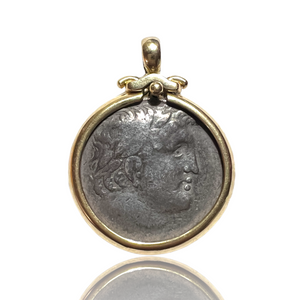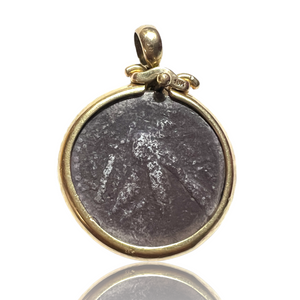Ancient Coin - Shekel of Tyre - Tetradrachm - Circa 95 BCE - Mounted in 18K gold
$4,200
Denomination: AR Tetradrachma
Date: Circa: 95 BCE
Mint: Tyre
Mount: 18K gold
Description: Shekle of Tyre. Obverse: Laureate head of beardless Melkarth. Reverse: Eagle standing on the beak of ship, palm branch transversely under wing, Phoenician letter “B” between legs, club, and AA in the left field, HPA monogram to right.
History: The great Phoenician metropolis of Tyre was a place of considerable antiquity, though it is said to have originated as a colony of its rival city Sidon. In 332 BC it put up a stubborn resistance to the advance of Alexander the Great but ultimately fell to the Greek invaders. Later, it formed part of the overseas empire of the Ptolemic kings of Egypt and, at the end of the 3rd century BC; it passed under the control of the Seleucid king of Syria. Finally, in 126 BC Tyre regained its autonomy and its subsequent coin issues are dated to this event. These include famous “shekels” which stretch in a long sequence down to Roman imperial times. This example comes relatively early in the series, dating to 95 BC. The shekels of Tyre have achieved a degree of notoriety through their identification as the most likely coinage with which Judas was paid his “thirty pieces of silver” for the betrayal of Christ. It has been suggested that some of the latest issues of the type, of the Julio-Claudian period, may have been struck in Jerusalem rather than Tyre. Melkarth, who came to be equated with the Greek Heracles, was especially revered at Tyre and appears on the Tyrian coinage from the late 5thcentury BC. The eagle was inherited from the Seleucid coinage of Tyre issued just prior to the city’s independence.
ID12115








